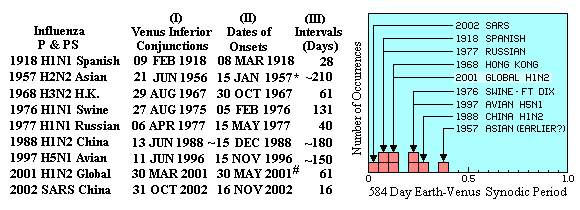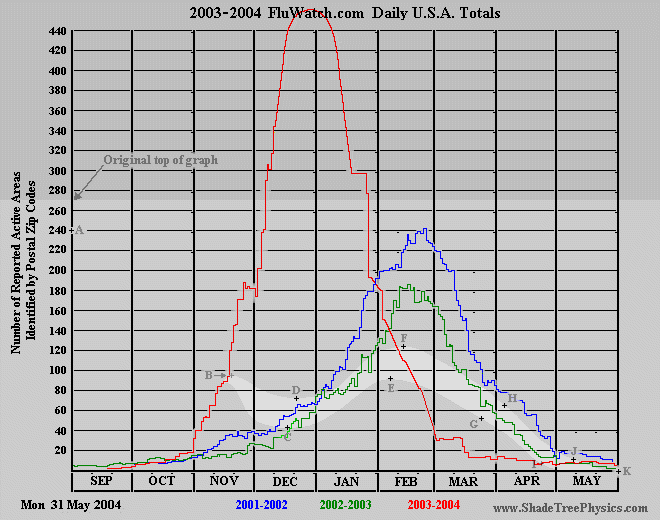USA Influenza Activity 2003-2004, Part 2b
Installed - 07 Sep 2003 - Latest update 09 November 2004.
Key words: Astrobiology, Exobiology, Influenza, Avian Influenza, Pneumonia, SARS, Venus
First time visitors to these pages may want to
review the following articles before proceeding.
Influenza From Space?
Life on Venus may be microbe clouds
* * *
The following table shows: (I) the dates of Venus inferior conjunctions
which preceded 20th century influenza Pandemics and Pandemic Scares (P&PS).
(II) onset dates for the disease outbreaks and (III) the intervals (in days)
between conjunctions and event onsets. These intervals are converted to
decimal fractions of the 584 day Earth-Venus synodic period and are
displayed in the histogram on the right, in which the width of each bin is 1/20th of
the synodic period (29.2 days per bin). The 1988 limited outbreaks of Influenza
A(H1N2), in China, the 2001 Global outbreak of Influenza A(H1N2) and the 2003
Severe Acute Respiratory Syndrome (SARS) outbreak have been added. See:
Sunspot Activity, Venus Inferior Conjunctions, and Biological
Events for further information on the 20th century events.]

*Some scholars report that the 1957 Asian flu was "making the rounds" in Vladivostok in December of 1956. Its earliest outbreak date and location are currently unknown to this writer.
In 1999 West Nile Virus (WNV) appeared on the North American continent one month after a major solar wind disruption, which occurred on May 10-12. See West Nile Virus for more details.
# According to a CDC report(4) the Influenza A(H1N2) strain was first found in India on May 31, 2001. Earliest identification had been listed on this page as Texas, USA in July 2001. [Added 1 June 2004.]
Flu Season Forecast for 2003-2004
07 Sep 2003
A special note, however, for June 2004. Venus will transit the sun (it's image will be able to be seen crossing the solar disk) on June 8. The proximity of Venus to the ecliptic may lead to an early delivery of new influenza strains, or influenza-like viruses. Two peaks of "drop in" activity might occur. With quiet sun, the first peak could occur as early as 2-3 weeks prior to June 8, and the latter peak 1-2 weeks following June 8. If there happens to be a high speed solar coronal mass ejection (CME) that reaches Venus on about June 8, there could be a special delivery to Earth's upper atmosphere one half to one day later.
May 15 through June 30 would be prime time to be doing upper atmospheric or near-Earth collections for possible biological visitors. Donald Barber made such recommendations in 1963. (1)
09 Sep 2003
In the 2003-2004 influenza season prediction above, reference is made to the strains that were in
circulation around the globe last year. Those strains appear to have included a number
flu-like illnesses of undiagnosed cause/origin. This researcher's gut feeling says that
some of these non influenza A or B illnesses may become more widespread (and in competition
with strains A and B). We should not be surprised if the 2003-2004 flu season turns out to the lowest
on record in recent years for the presence of A and B.
See Influenza 1918, A Venus Connection? for the rationale behind the comments above.
Updated Forecast 14-15 Nov 2003
The author re-affirms his 09 Sep gut feeling statement, "We should not be surprised if the 2003-2004 flu season turns out to the lowest on record in recent years for the presence of A and B." The present atypical high level of flu activity should taper off by mid December and the FluWatch.com seasonal peak should still end up below those for the 2001-2002 and 2002-2003 seasons. Further solar CMEs which impact Earth during this flu season should not trigger any substantial new influenza outbreaks.
Here is a predicted flu activity diagram for the remainder of the 2003-2004 season. The lighter grey area represents the author's "gut feeling" as to the limits for the actual upcoming activity levels. The 2003-2004 activity plot will be updated throughout the season.

Predicted and Actual Flu Activity Levels for Remainder of 2003-2004 Flu Season
Alternate Title - "Where's my saw?!"

Analysis of updated Forecast
[Added 18 March 2004.]
See Venus Transit, Biohazard? for a histogram continuing into the summer of 2004. [Added 24 June 2004.]
Global Developments, 2003-2004 Flu Season
Thur 18 Sep 2003, IndiaPanic spreads in Indian state on fatal mystery disease
Panic is spreading in India's northern Himachal Pradesh state after the deaths of 10 people from a mystery disease. Doctors in the state's capital Shimla say the condition of several other patients is also critical. Most of the patients who were admitted to hospital complained of high fever and severe headaches. While doctors have yet to diagnose the disease, relatives of those affected are fearing the return of a killer plague. ...
Source: Channel News Asia 18 Sep 2003 1209 hrs (SST) 0409 hrs (GMT) [edited].
Copied from ProMED Digest Vol. 2003 : No. 375.
[Similar, as yet undiagnosed, outbreaks apparently also occurred in the 2002-2003 time frame.]
To subscribe to ProMED Digest, send a message to majordomo@promedmail.org and type "subscribe promed-digest" in the message body.
Thur 18 Sep 2003, New Jersey USA
Man's death man be linked to [West Nile ] virus [Paraphrased extracts]
A man who had been hospitalized three times over the summer for numerous medical problems
died on August 13. At the time of his death the cause of death was listed at pneumonia, however
on August 29th the New Jersey state Public Health and Environmental Laboratories found evidence
of West Nile virus (WNV) in his blood. On Tuesday, 17 September, the CDC confirmed the WNV finding.
The blood tests had been taken because the man was suffering fever and mental confusion. (In
many cases a West Nile virus infection presents symptoms resembling a mild case of influenza.)
Source:Burlington County Times - Brian Scheid, Staff Writer
Article is no longer on line. [16 Nov 2011]
Top |